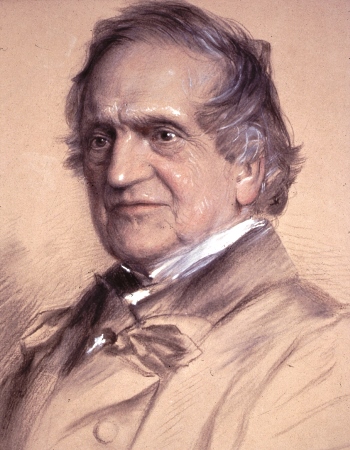 This year is the bicentenary of Adam Sedgwick’s appointment as Woodwardian Professor. Douglas Palmer* writes.
This year is the bicentenary of Adam Sedgwick’s appointment as Woodwardian Professor. Douglas Palmer* writes.
Adam Sedgwick (1785-1873) graduated from Trinity College, Cambridge in 1808, became a Fellow of the College in 1810 and Vice-master in 1845. To fulfill the conditions of fellowship, he was ordained in 1817 and later granted a prebendary stall in Norwich Cathedral (1834). In 1818 he was elected to the Woodwardian professorship, and to fellowship of the Geological Society of London (becoming President 1830-1831, winning the Wollaston Medal in 1851), followed by fellowship of the Royal Society in 1821 (where he won the Copley Medal in 1863). Sedgwick had undoubtedly arrived – becoming part of the established network of British science and one of the most important geologists of the 19th Century.
Picture left: Adam Sedgwick at 82
Cambridge
As a lifelong Cambridge don, the Reverend Professor delivered his first lecture course in 1819 (becoming one of the first to fulfill this requirement in Woodward’s bequest!). Sedgwick’s lectures proved popular with ‘town and gown’ - including women, whose admission to lectures was unusual for the time. However by 1870 and his last lecture course, three years after the foundation of the first women’s college (Girton), Sedgwick was referring to aspiring female undergraduates as ‘nasty forward minxes’.
Despite this, Sedgwick was a university reformer, campaigning in 1834 for the abolition of the religious test, which only allowed members of the Church of England to enter the University (it was finally removed in 1869). When Prince Albert became Chancellor of the University in 1847, he appointed Sedgwick as his secretary and then as a member of the Royal Commission on University Reform in 1850.
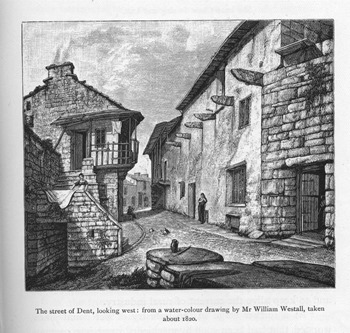 Royal connections
Royal connections
Sedgwick’s Royal connection began in 1843 when he showed Queen Victoria and Prince Albert around the new University Museum of Geology in the recently built Cockerell building. Sedgwick’s admiration was evidently reciprocated, as invitations to Osborne (1847), Balmoral (1859) and Windsor (1863) duly followed.
If young geologists today have heard Sedgwick’s name at all they will probably associate it with the Sedgwick Museum in Cambridge. However, anyone delving into the details of Lower Palaeozoic biostratigraphy will become more aware of Adam Sedgwick’s geological achievements.
Picture, right: A view of Dent around 1820 where Sedgwick was brought up.
So, beyond the bald facts of his career, who was Adam Sedgwick? Is it possible to get a sense of how he rose from being a Yorkshire grammar-school boy to a pillar of Victorian Establishment?
Bootstraps
Sedgwick’s early life and education was a successful 19th Century aspirational parable of good genes, a supportive family and social environment, and hard work. Born in 1785 and bred in Dent, Yorkshire, Adam was one of the seven children of a local schoolmaster – the Rev. John Sedgwick and his wife Margaret.
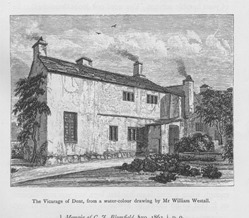 Clever but relatively unrefined Dalesmen, Adam, his father and two of his younger brothers all gained entry to the University of Cambridge - Adam helped by tutoring from local physician and mathematician, John Dawson. Without much money, and again like his father, Adam was assisted by a sizarship (a sizar is an undergraduate at Cambridge or Trinity College, Dublin, who received financial help from the college, formerly in return for certain menial duties) before winning a Trinity College scholarship (1807) and graduating as 5th Wrangler in 1808 (A ‘wrangler’ is a person placed in the first class of the mathematical tripos).
Clever but relatively unrefined Dalesmen, Adam, his father and two of his younger brothers all gained entry to the University of Cambridge - Adam helped by tutoring from local physician and mathematician, John Dawson. Without much money, and again like his father, Adam was assisted by a sizarship (a sizar is an undergraduate at Cambridge or Trinity College, Dublin, who received financial help from the college, formerly in return for certain menial duties) before winning a Trinity College scholarship (1807) and graduating as 5th Wrangler in 1808 (A ‘wrangler’ is a person placed in the first class of the mathematical tripos).
Picture, left: The Dent vicarage where Sedgwick was born and his father was the priest.
Further hard work precipitated a breakdown in his health; but in 1810 he was awarded a college Fellowship. He still had to earn his living by the tutorial teaching of undergraduate mathematics, which he found unrewarding (both financially and intellectually). The subject just did not interest him. Nor did he wish to follow in his father’s footsteps as schoolmaster and priest. Seduced by the intellectual stimuli of collegiate life in Cambridge, Adam needed a more engaging subject than maths or theology - but what?
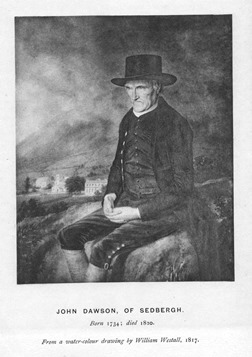 A glorious & healthy field
A glorious & healthy field
None of Sedgwick’s biographers has found any evidence of particular interest in geology prior to his entering the competition for the Woodwardian chair. Indeed when, in 1859, he looked back on his reasons for turning to geology, Sedgwick wrote: “I knew very little indeed of geology – just enough to know that it was a glorious and healthy field in which I might find ample enjoyment and better health”. As a countryman used to being out on the Fells in all weathers, he believed in the restorative effects of nature.
Picture, right: John Dawson, the local genius who tutored Sedgwick in maths
With little or no geological background Sedgwick might seem a surprising choice for the Woodwardian chair; but the position was something of a sinecure since the subject was not examined at the time. Its duties were not onerous but the stipend was only £100 a year. Nevertheless, Sedgwick was an inspired choice and went on to fully justify his election. He said: “hitherto I have never turned a stone; henceforth I will leave no stone unturned”. He kept his promise.
Married to the Museum
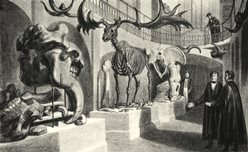 But there was a personal cost to be paid. As Sedgwick ruefully noted in 1858, “Woodward put the ban of domestic sterility upon his Professor, but my Museum is in the place of wife and children”. Clearly Sedgwick had not fully taken this into account when competing for the post, vacated upon the marriage of the previous incumbent John Hailstone.
But there was a personal cost to be paid. As Sedgwick ruefully noted in 1858, “Woodward put the ban of domestic sterility upon his Professor, but my Museum is in the place of wife and children”. Clearly Sedgwick had not fully taken this into account when competing for the post, vacated upon the marriage of the previous incumbent John Hailstone.
Picture, left: Sedgwick’s Geology Museum in the Cockerell building c.1850
Sedgwick’s zeal as a lecturer, field geologist and collector firmly established the science of geology within the University - despite its having no part in any examination until the foundation of the Natural Science Tripos in the 1850s. Under Sedgwick, the Museum collections grew well beyond the core 11,000 specimens endowed by John Woodward in 1728. Sedgwick himself collected thousands of specimens and bought collections and important specimens from the likes of Mary Anning. He also pressured the University authorities to provide more space for the collection.
When Queen Victoria and Prince Albert visited Cambridge in 1843, Sedgwick proudly showed them around his new Museum in the recently built Cockerell Building. The royal couple was suitably impressed and when the Queen asked where one of the ichthyosaurs came from, Sedgwick replied that it was ‘a delegate from the monsters of the lower world to greet Her Majesty on her arrival in the University’.
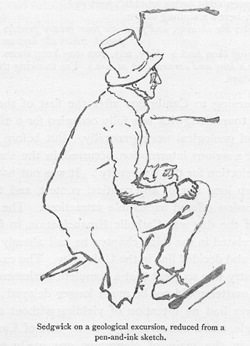 Achievements
Achievements
From the start of his geological career Sedgwick embarked upon fieldwork across Britain, initially in mining areas, especially southwest England, then the Isle of Wight and the Lake District.
As Clark and Hughes detail in their ‘Life and Letters’, for nearly three decades from the early 1820s Sedgwick was indefatigable in his pursuit of geology. His mapping of the Lake District, North Wales and Devon was a major achievement. He pioneered understanding of the complex structure and slaty cleavage of these ancient terranes. And, in collaboration with Murchison he founded the Cambrian and Devonian Systems.
Picture (right): Sedgwick sketched in the field
By the 1850s ecclesiastical duties and ill health prevented Sedgwick from doing any innovative geological work. His geology became out of touch with the times, and he viewed with dismay the publication of the ‘Origin of Species’ (1859) by one of his most famous pupils. As he wrote to Darwin: “You have deserted…the true method of induction”. Although Sedgwick accepted many of the transformative discoveries of early 19th Century geology, he was an evangelical Christian and baulked at the theory of evolution - and especially its implications for humankind.
Postscript
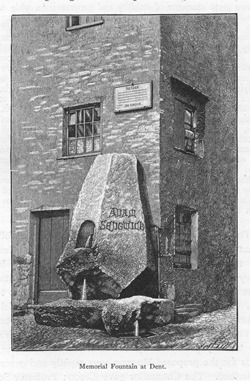 Such was the esteem in which Sedgwick was held that, upon his death in 1873, a public subscription raised £12,000 towards a memorial building to house his hugely expanded geological collections. Although it took over two decades to realise, the Sedgwick Museum was opened in 1904 by King Edward VII. Sedgwick had first met Edward, aged six, at Osborne in 1847 when he ‘entertained’ the royal family with a droll story of how a Cambridgeshire woman survived burial in snow for eight days in the winter of 1799.
Such was the esteem in which Sedgwick was held that, upon his death in 1873, a public subscription raised £12,000 towards a memorial building to house his hugely expanded geological collections. Although it took over two decades to realise, the Sedgwick Museum was opened in 1904 by King Edward VII. Sedgwick had first met Edward, aged six, at Osborne in 1847 when he ‘entertained’ the royal family with a droll story of how a Cambridgeshire woman survived burial in snow for eight days in the winter of 1799.
Picture left: Sedgwick’s memorial in Dent
Author
*Douglas Palmer, author, is Public Programmes Coordinator for the Sedgwick Museum, Cambridge.
Reference
Clark, J.W. and McKenny Hughes (eds) 1890. The Life and Letters of Adam Sedgwick. Cambridge University Press ( two vols) i-xiii, 1-539 and i-vii, 1-640.